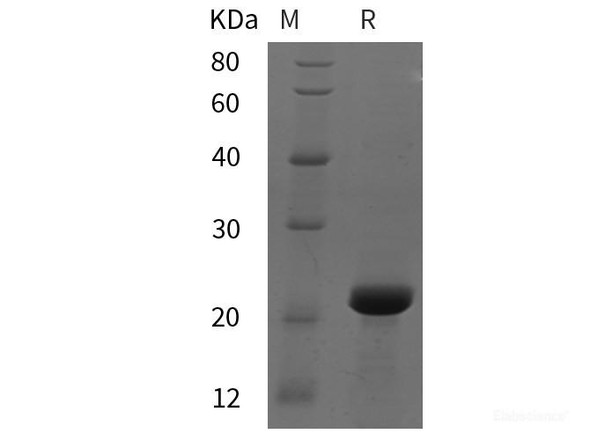Description
| Product Name: | Mouse ANGPTL4 Recombinant Protein (His tag) |
| Product Code: | RPES6117 |
| Size: | 20µg |
| Species: | Mouse |
| Expression Host: | HEK293 Cells |
| Synonyms: | Angiopoietin-related protein 4, 425O18-1, Angiopoietin-like protein 4, Fasting-induced adipose factor, Hepatic fibrinogen/angiopoietin-related protein, HFARP, Secreted protein Bk89, Angptl4, Farp, Fiaf, Ng27 |
| Mol Mass: | 26.73 kDa |
| AP Mol Mass: | 40 kDa |
| Tag: | C-His |
| Purity: | > 95 % as determined by reducing SDS-PAGE. |
| Endotoxin Level: | Please contact us for more information. |
| Bio Activity: | Testing in progress |
| Sequence: | Lys167-Ser410 |
| Accession: | Q9Z1P8 |
| Storage: | Generally, lyophilized proteins are stable for up to 12 months when stored at -20 to -80°C. Reconstituted protein solution can be stored at 4-8°C for 2-7 days. Aliquots of reconstituted samples are stable at < -20°C for 3 months. |
| Shipping: | This product is provided as lyophilized powder which is shipped with ice packs. |
| Formulation: | Lyophilized from sterile PBS, pH 7.4. Normally 5 % - 8 % trehalose, mannitol and 0.01% Tween80 are added as protectants before lyophilization. Please refer to the specific buffer information in the printed manual. |
| Reconstitution: | Please refer to the printed manual for detailed information. |
| Background: | Angiopoietin-related protein 4(ANGPTL4)is a secreted protein and contains 1 fibrinogen C-terminal domain. The protein may act as a regulator of angiogenesis and modulate tumorigenesis. It inhibits proliferation, migration, and tubule formation of endothelial cells and reduces vascular leakage. ANGPTL4 may exert a protective function on endothelial cells through an endocrine action. It is directly involved in regulating glucose homeostasis, lipid metabolism, and insulin sensitivity (By similarity). In response to hypoxia, the unprocessed form of the protein accumulates in the subendothelial extracellular matrix (ECM). The matrix-associated and immobilized unprocessed form limits the formation of actin stress fibers and focal contacts in the adhering endothelial cells and inhibits their adhesion. It also decreases motility of endothelial cells and inhibits the sprouting and tube formation. |






